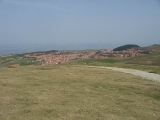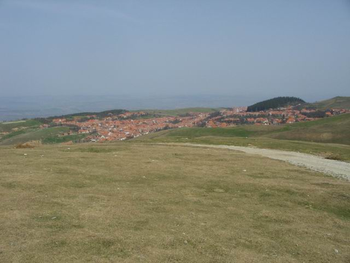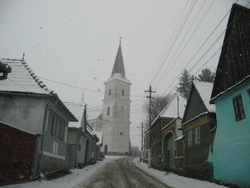
Marginimea Sibiului
Encyclopedia
Mărginimea Sibiului is an area which comprises 18 Romania
n localities in the south-western part of the Sibiu County
, in southern Transylvania
, all of them having a unique ethnological, cultural, architectural and historical heritage.
in Transylvania
- the city of Sibiu
, and has an area of over 200 km² limited by the Sadu River in the south and the Sălişte river in the north. The villages are situated around the valleys of different rivers which flow from the Cindrel Mountains
through the Transylvanian Plateau
.
 The region comprises the following villages and towns:
The region comprises the following villages and towns:
, which dates to 1204, followed by Tălmaciu
(1318), Orlat
(1322) and Sălişte
(1354). Throughout their history, these settlements were sometimes (along with the Ţara Făgăraşului) part of the Romanian principality of Wallachia
. An important event in the area was the establishment in the 18th century by Maria Theresa
of the 1st Romanian border regiment at Orlat
. Also, Boiţa
was a border village, at the end of the passageway along the Olt River
.
s who continuously crossed the Carpathian Mountains
, maintaining the essential link between the Romanian communities to the north and south of the mountains. Activities closely related to shepherding, such as wool and leather manufacturing, are still well maintained in the area to this day.
which is by far the main religion of the inhabitants.
The architecture is strongly influenced by the Saxons, with big imposing houses, with an internal yard well closed on all sides. Wood was traditionally the main material used in construction, but bricks have replaced it in the last hundred years; today, only a small number of wooden houses can be found.
 The oldest church in the area can be found at Sălişte
The oldest church in the area can be found at Sălişte
; it is a painted church dating to 1674. Other old churches are the wooden church from Poiana Sibiului
- 1771 - and the church from Tălmăcel - 1776.
In Răşinari
and Sălişte
there are some small village museums and also memorial houses. Emil Cioran
is the best-known personality to have been born in this area. Additionally, Octavian Goga
, a Romanian poet and a politician from the interwar period, along with more than six Romanian academicians
, are natives of this area. There is a museum in Sibiel dedicated to glass-painted icons.
Close to Tilişca
there can be found the remains of a Dacia
n citadel, situated on a hilltop with a panoramic view towards the Transylvanian Plateau
.
A more modern museum can be found in Sadu
, the place where the first electrical hydro-power plant was built in 1896 - the third one in Europe.
Romania
Romania is a country located at the crossroads of Central and Southeastern Europe, on the Lower Danube, within and outside the Carpathian arch, bordering on the Black Sea...
n localities in the south-western part of the Sibiu County
Sibiu County
Sibiu is a county of Romania, in the historical region Transylvania, with the capital city Sibiu.-Demographics:In 2002, it had a population of 421,724 and the population density was 78/km²....
, in southern Transylvania
Transylvania
Transylvania is a historical region in the central part of Romania. Bounded on the east and south by the Carpathian mountain range, historical Transylvania extended in the west to the Apuseni Mountains; however, the term sometimes encompasses not only Transylvania proper, but also the historical...
, all of them having a unique ethnological, cultural, architectural and historical heritage.
Position
The area is situated in the immediate vicinity of the cradle of Saxon CivilisationTransylvanian Saxons
The Transylvanian Saxons are a people of German ethnicity who settled in Transylvania from the 12th century onwards.The colonization of Transylvania by Germans was begun by King Géza II of Hungary . For decades, the main task of the German settlers was to defend the southeastern border of the...
in Transylvania
Transylvania
Transylvania is a historical region in the central part of Romania. Bounded on the east and south by the Carpathian mountain range, historical Transylvania extended in the west to the Apuseni Mountains; however, the term sometimes encompasses not only Transylvania proper, but also the historical...
- the city of Sibiu
Sibiu
Sibiu is a city in Transylvania, Romania with a population of 154,548. Located some 282 km north-west of Bucharest, the city straddles the Cibin River, a tributary of the river Olt...
, and has an area of over 200 km² limited by the Sadu River in the south and the Sălişte river in the north. The villages are situated around the valleys of different rivers which flow from the Cindrel Mountains
Cindrel Mountains
Cindrel Mountains are a group of mountains in central Romania in the centre of the Southern Carpathians, in the North-East of the Parâng Mountains group....
through the Transylvanian Plateau
Transylvanian Plateau
The Transylvanian Plateau is a plateau in central Romania.The plateau lies within and takes its name from the historical region of Transylvania, and is almost entirely surrounded by the Eastern, Southern and Romanian Western branches of the Carpathian Mountains...
.

- BoiţaBoitaBoiţa is a commune in Sibiu County, Transylvania, Romania, at the foothills of the Cindrel Mountains, 22 km south of the county capital Sibiu, in the Mărginimea Sibiului ethnographic area, on the main road between Sibiu and the southern part of Romania, the National road 7/European route 81,...
- Fântânele(Cacova Sibiului), Sibiu
- GaleşGales-Places:*Gales Township, Redwood County, Minnesota*Gales Addition, Washington*Gales Creek *Gales Ferry*Gales Point, Belize*Galeş, a village in Sălişte town, Sibiu County, Romania*The Spanish language and Portuguese language word for Wales...
- Gura RâuluiGura RâuluiGura Râului is a commune in Sibiu County, Transylvania, Romania, at the foothills of the Cindrel Mountains, 20 km west of the county capital Sibiu, in the Mărginimea Sibiului ethnographic area. It is composed of a single village, Gura Râului....
- JinaJina, SibiuJina is a commune in Sibiu County, Transylvania, Romania, in the Cindrel Mountains, 40 km west of the county capital Sibiu, in the Mărginimea Sibiului ethnographic area. It is composed of a single village, Jina....
- OrlatOrlatOrlat is a commune in Sibiu County, Transylvania, Romania, at the foothills of the Cindrel Mountains, 17 km west of the county capital Sibiu, in the Mărginimea Sibiului ethnographic area. It is composed of a single village, Orlat....
- Poiana SibiuluiPoiana SibiuluiPoiana Sibiului is a commune in Sibiu County, Transylvania, Romania. It is composed of a single village, Poiana Sibiului. The name means "the glade of Sibiu".-Position:...
- PoplacaPoplacaPoplaca is a commune in Sibiu County, Transylvania, Romania, at the foothills of the Cindrel Mountains, 12 km south-west of the county capital Sibiu, in the Mărginimea Sibiului ethnographic area. It is composed of a single village, Poplaca....
- RăşinariRăşinariRăşinari is a commune in Sibiu County, Transylvania, Romania. It has a population of 5,645 inhabitants and is composed of two villages, Prislop and Răşinari....
- Râul SaduluiRâul SaduluiRâu Sadului is a commune in Sibiu County, Transylvania, Romania, at the foothills of the Cindrel Mountains, 30 km south of the county capital Sibiu, in the Mărginimea Sibiului ethnographical area. It is composed of a single village, Râu Sadului....
- Rod
- SaduSaduSadu is a commune in Sibiu County, Transylvania, Romania, at the foothills of the Cindrel Mountains, 27 km south of the county capital Sibiu, in the Mărginimea Sibiului ethnographic area...
- SălişteSalisteSălişte is a town in Sibiu County in the centre of Romania, 21 km west of the county capital, Sibiu, the main locality in the Mărginimea Sibiului area.-Geography:...
(town) - Sibiel
- Tălmăcel
- TilişcaTiliscaTilişca is a commune in Sibiu County, Transylvania, Romania, in the Cindrel Mountains, 26 km west of the county capital Sibiu, in the Mărginimea Sibiului ethnographic area. It is composed of two villages, Rod and Tilişca....
- Vale
Brief history
The oldest known village is RăşinariRăşinari
Răşinari is a commune in Sibiu County, Transylvania, Romania. It has a population of 5,645 inhabitants and is composed of two villages, Prislop and Răşinari....
, which dates to 1204, followed by Tălmaciu
Talmaciu
Tălmaciu is a town in Sibiu County, in central Romania, 20 km south of the county capital Sibiu. It lies on the east end of the Mărginimea Sibiului area.-Geography:...
(1318), Orlat
Orlat
Orlat is a commune in Sibiu County, Transylvania, Romania, at the foothills of the Cindrel Mountains, 17 km west of the county capital Sibiu, in the Mărginimea Sibiului ethnographic area. It is composed of a single village, Orlat....
(1322) and Sălişte
Saliste
Sălişte is a town in Sibiu County in the centre of Romania, 21 km west of the county capital, Sibiu, the main locality in the Mărginimea Sibiului area.-Geography:...
(1354). Throughout their history, these settlements were sometimes (along with the Ţara Făgăraşului) part of the Romanian principality of Wallachia
Wallachia
Wallachia or Walachia is a historical and geographical region of Romania. It is situated north of the Danube and south of the Southern Carpathians...
. An important event in the area was the establishment in the 18th century by Maria Theresa
Maria Theresa of Austria
Maria Theresa Walburga Amalia Christina was the only female ruler of the Habsburg dominions and the last of the House of Habsburg. She was the sovereign of Austria, Hungary, Croatia, Bohemia, Mantua, Milan, Lodomeria and Galicia, the Austrian Netherlands and Parma...
of the 1st Romanian border regiment at Orlat
Orlat
Orlat is a commune in Sibiu County, Transylvania, Romania, at the foothills of the Cindrel Mountains, 17 km west of the county capital Sibiu, in the Mărginimea Sibiului ethnographic area. It is composed of a single village, Orlat....
. Also, Boiţa
Boita
Boiţa is a commune in Sibiu County, Transylvania, Romania, at the foothills of the Cindrel Mountains, 22 km south of the county capital Sibiu, in the Mărginimea Sibiului ethnographic area, on the main road between Sibiu and the southern part of Romania, the National road 7/European route 81,...
was a border village, at the end of the passageway along the Olt River
Olt River
The Olt River is a river in Romania. It is the longest river flowing exclusively through Romania. Its source is in the Hăşmaş Mountains of the eastern Carpathian Mountains, near the village Bălan. It flows through the Romanian counties Harghita, Covasna, Braşov, Sibiu, Vâlcea and Olt...
.
Occupations
Predominantly, the people were shepherdShepherd
A shepherd is a person who tends, feeds or guards flocks of sheep.- Origins :Shepherding is one of the oldest occupations, beginning some 6,000 years ago in Asia Minor. Sheep were kept for their milk, meat and especially their wool...
s who continuously crossed the Carpathian Mountains
Carpathian Mountains
The Carpathian Mountains or Carpathians are a range of mountains forming an arc roughly long across Central and Eastern Europe, making them the second-longest mountain range in Europe...
, maintaining the essential link between the Romanian communities to the north and south of the mountains. Activities closely related to shepherding, such as wool and leather manufacturing, are still well maintained in the area to this day.
Characteristics
The area has a rich variety of customs related to different times in the year and in life. To this day, it is a custom to wear the traditional folk costume - black and white, with a particular round shaped hat without borders worn by the men at the most important occasions. Painting on glass is a tradition in this area, strongly connected to the Romanian Orthodox ChurchRomanian Orthodox Church
The Romanian Orthodox Church is an autocephalous Eastern Orthodox church. It is in full communion with other Eastern Orthodox churches, and is ranked seventh in order of precedence. The Primate of the church has the title of Patriarch...
which is by far the main religion of the inhabitants.
The architecture is strongly influenced by the Saxons, with big imposing houses, with an internal yard well closed on all sides. Wood was traditionally the main material used in construction, but bricks have replaced it in the last hundred years; today, only a small number of wooden houses can be found.
Places to see

Saliste
Sălişte is a town in Sibiu County in the centre of Romania, 21 km west of the county capital, Sibiu, the main locality in the Mărginimea Sibiului area.-Geography:...
; it is a painted church dating to 1674. Other old churches are the wooden church from Poiana Sibiului
Poiana Sibiului
Poiana Sibiului is a commune in Sibiu County, Transylvania, Romania. It is composed of a single village, Poiana Sibiului. The name means "the glade of Sibiu".-Position:...
- 1771 - and the church from Tălmăcel - 1776.
In Răşinari
Răşinari
Răşinari is a commune in Sibiu County, Transylvania, Romania. It has a population of 5,645 inhabitants and is composed of two villages, Prislop and Răşinari....
and Sălişte
Saliste
Sălişte is a town in Sibiu County in the centre of Romania, 21 km west of the county capital, Sibiu, the main locality in the Mărginimea Sibiului area.-Geography:...
there are some small village museums and also memorial houses. Emil Cioran
Emil Cioran
-Early life:Emil M. Cioran was born in Răşinari, Sibiu County, which was part of Austria-Hungary at the time. His father, Emilian Cioran, was a Romanian Orthodox priest, while his mother, Elvira Cioran , was originally from Veneţia de Jos, a commune near Făgăraş.After studying humanities at the...
is the best-known personality to have been born in this area. Additionally, Octavian Goga
Octavian Goga
Octavian Goga was a Romanian politician, poet, playwright, journalist, and translator.-Life:Born in Răşinari, nearby Sibiu, he was an active member in the Romanian nationalistic movement in Transylvania and of its leading group, the Romanian National Party in Austria-Hungary. Before World War I,...
, a Romanian poet and a politician from the interwar period, along with more than six Romanian academicians
Romanian Academy
The Romanian Academy is a cultural forum founded in Bucharest, Romania, in 1866. It covers the scientific, artistic and literary domains. The academy has 181 acting members who are elected for life....
, are natives of this area. There is a museum in Sibiel dedicated to glass-painted icons.
Close to Tilişca
Tilisca
Tilişca is a commune in Sibiu County, Transylvania, Romania, in the Cindrel Mountains, 26 km west of the county capital Sibiu, in the Mărginimea Sibiului ethnographic area. It is composed of two villages, Rod and Tilişca....
there can be found the remains of a Dacia
Dacia
In ancient geography, especially in Roman sources, Dacia was the land inhabited by the Dacians or Getae as they were known by the Greeks—the branch of the Thracians north of the Haemus range...
n citadel, situated on a hilltop with a panoramic view towards the Transylvanian Plateau
Transylvanian Plateau
The Transylvanian Plateau is a plateau in central Romania.The plateau lies within and takes its name from the historical region of Transylvania, and is almost entirely surrounded by the Eastern, Southern and Romanian Western branches of the Carpathian Mountains...
.
A more modern museum can be found in Sadu
Sadu
Sadu is a commune in Sibiu County, Transylvania, Romania, at the foothills of the Cindrel Mountains, 27 km south of the county capital Sibiu, in the Mărginimea Sibiului ethnographic area...
, the place where the first electrical hydro-power plant was built in 1896 - the third one in Europe.

